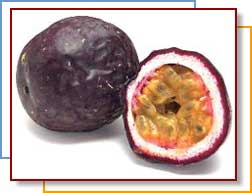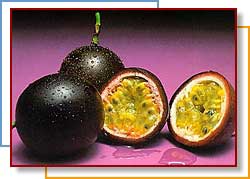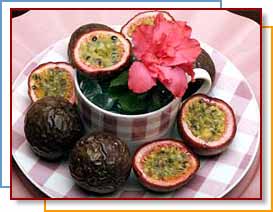
An egg-shaped tropical fruit that is also called a purple granadilla,
the passion fruit has a brittle, wrinkled purple-brown rind enclosing
flesh-covered seeds, something like a pomegranate (granadilla means
"little pomegranate" in Spanish). The seeds are edible so you
can eat the orange pulp straight from the shell. Passion fruit is more
commonly sieved and its highly aromatic pulp and juice are used as a
flavoring for beverages and sauces. The pulp has an intense aromatic
flavor, while the texture is jelly-like and watery. The flavor is likened
to guava.
Native to Brazil, passion fruits are grown in Hawaii, Florida, and
California. These crops, along with imports from New Zealand, keep passion
fruit on the market all year.
|
| Passion
Fruit |
Serving
size 118g
|
Amounts
Per Serving |
% Daily
Value |
| Calories 110 |
|
| Calories
from Fat 5 |
|
| Total Fat 1g |
2% |
| Saturated
Fat 0g |
0% |
| Sodium 35mg |
1% |
| Total
Carbohydrate 28g |
9% |
|
Dietary Fiber 12g |
48% |
|
Sugars 13g |
|
| Protein 3g |
|
| Vitamin A |
30% |
| Vitamin C |
60% |
| Calcium |
2% |
| Iron |
10% |
* Percent Daily Values are based on a
2,000 calorie diet. |
|
| |
|
Passion fruit is an excellect source of vitamins A and C. One passion fruit has only 16 calories. When eaten
with the seeds, a serving is an excellent source of fiber.
Choose large, heavy, firm fruit. When ripe, it has wrinkled, dimpled,
deep purple skin. Skin is old-looking, but does not mean the fruit is
rotten. Mold does not affect quality and can be wiped off. Fruit color is
green when they are immature, changing to shades of purple, red or yellow
as they ripen. Leave at room temperature to ripen. The skin will wrinkle,
but the fruit will not soften much. Once ripe, store in the refrigerator
up to 1 week.
Passion Fruit is generally eaten fresh but may be cooked for use in
sauces and fillings. Begin by cutting the fruit in half and scooping out
the fleshy pulp with a spoon. Spoon the pulp over ice cream or other soft
fruits. The pulp makes a delicious jam or jelly and the seeds add a unique
crunchy texture. To remove seeds: Strain in a non-aluminum sieve, or use
cheesecloth, squeezing to extract the juice.
New Zealand Passion Fruit is purple while the Hawaiian variety is
yellow.
- Purple Form
-
-
 Black Knight Black Knight
Developed in Massachusetts. This variety is fragrant with a dark
purple-black fruit, the size and shape of large egg and excellent
flavor.
-
- Edgehill
Originated in Vista, Calif. Similar to Black Knight, but more
vigorous. It has a longer growing period and produces a larger
purple fruit. One of the best outdoor cultivars for Southern
California.
-
- Frederick
Originated in Lincoln Acres, Calif. This variety is a large, nearly
oval fruit, greenish-purple with reddish cast, slightly tart flavor,
good for eating out of hand, and excellent for juicing.
-
- Kahuna
This variety is very large with a medium purple color in the fruit.
It has a sweet, tart flavor that is good for juicing.
-
- Paul Ecke
Originated in Encinitas, Calif., It is a medium-sized purple fruit
of very good quality that is suitable for juicing and eating out of
hand.
-
- Purple Giant
This is a very large variety of fruit and is dark purple when
mature.
-
- Red Rover
Originated in Lincoln Acres, Calif. This variety is medium to large,
roundish, with a rind in an attractive clear red color. This variety
has a sweet, notably rich flavor with tart overtones. It is good for
eating out of hand or juicing.
-
- Yellow Form
-
- Brazilian Golden
Large, golden-yellow fruits, larger than standard forms, the flavor
is somewhat tart. It has an extremely vigorous vine, requiring
cross-pollination. This variety has extra large, fragrant flowers,
white with a dark center that blooms during mid-summer. Produces one
large crop beginning in late August or early September
-
- Golden Giant
A large yellow-fruited cultivar that originated in Australia.
Recipes

Passion Fruit Cup
Makes 2 servings
Each serving equals 1 1/2 cups of fruit or vegetables
Source: Produce for Better Health
Ingredients
2 passion fruits
1 Tbsp honey
lime juice
1 large kiwi, peeled and sliced
1 banana, sliced
1 cup red grapes seedless, cut in half
Cut the top from each passion fruit and scoop out the pulp. In a bowl,
combine passion fruit with honey and lime juice to taste. Combine other
fruits, toss gently and serve.
Nutritional analysis per serving: Calories 152, Protein 2g, Fat 1g,
Calories From Fat 5%, Cholesterol 0mg, Carbohydrates 39g, Fiber 5g, Sodium
10mg.

Find more in our
recipe database!
|



